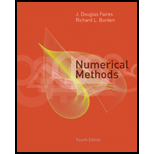
Numerical Methods
4th Edition
ISBN: 9780495114765
Author: J. Douglas Faires, BURDEN
Publisher: Cengage Learning
expand_more
expand_more
format_list_bulleted
Textbook Question
Chapter 2.2, Problem 1E
Use the Bisection method to find
Expert Solution & Answer
Want to see the full answer?
Check out a sample textbook solution
Students have asked these similar questions
Business
Please answer first one
Answer number 2
Chapter 2 Solutions
Numerical Methods
Ch. 2.2 - Use the Bisection method to find p3 for f(x)=xcosx...Ch. 2.2 - Let f(x)=3(x+1)x12(x1). Use the Bisection method...Ch. 2.2 - Use the Bisection method to find solutions...Ch. 2.2 - Use the Bisection method to find solutions...Ch. 2.2 - Sketch the graphs of y=x and y=2sinx. Use the...Ch. 2.2 - Sketch the graphs of y=x and y=tanx. Use the...Ch. 2.2 - Let f(x)=(x+2)(x+1)x(x1)3(x2). To which zero of f...Ch. 2.2 - Let f(x)=(x+2)(x+1)2x(x1)3(x2). To which zero of f...Ch. 2.2 - Use the Bisection method to find an approximation...Ch. 2.2 - Use the Bisection method to find an approximation...
Ch. 2.2 - Find a bound for the number of Bisection method...Ch. 2.2 - Prob. 12ECh. 2.2 - The function defined by f(x)=sinx has zeros at...Ch. 2.3 - Let f(x)=x26,p0=3, and p1=2. Find p3 using each...Ch. 2.3 - Prob. 2ECh. 2.3 - Use the Secant method to find solutions accurate...Ch. 2.3 - Use the Secant method to find solutions accurate...Ch. 2.3 - Prob. 5ECh. 2.3 - Prob. 6ECh. 2.3 - Use the Secant method to find all four solutions...Ch. 2.3 - Prob. 8ECh. 2.3 - Prob. 9ECh. 2.3 - Prob. 10ECh. 2.3 - Prob. 11ECh. 2.3 - Prob. 12ECh. 2.3 - The fourth-degree polynomial...Ch. 2.3 - The function f(x)=tanx6 has a zero at (1/) arctan...Ch. 2.3 - The sum of two numbers is 20. If each number is...Ch. 2.3 - A trough of length L has a cross section in the...Ch. 2.3 - Prob. 17ECh. 2.4 - Let f(x)=x26 and p0=1. Use Newtons method to find...Ch. 2.4 - Prob. 2ECh. 2.4 - Prob. 3ECh. 2.4 - Prob. 4ECh. 2.4 - Prob. 5ECh. 2.4 - Use Newtons method to find all solutions of...Ch. 2.4 - Prob. 7ECh. 2.4 - Prob. 8ECh. 2.4 - Prob. 9ECh. 2.4 - Prob. 10ECh. 2.4 - Prob. 11ECh. 2.4 - Prob. 12ECh. 2.4 - Prob. 13ECh. 2.4 - Prob. 14ECh. 2.4 - Prob. 15ECh. 2.4 - Prob. 16ECh. 2.4 - Prob. 17ECh. 2.4 - Prob. 18ECh. 2.4 - Prob. 19ECh. 2.4 - Prob. 20ECh. 2.5 - The following sequences are linearly convergent....Ch. 2.5 - Prob. 2ECh. 2.5 - Prob. 3ECh. 2.5 - Prob. 4ECh. 2.5 - Prob. 5ECh. 2.5 - Prob. 6ECh. 2.5 - Prob. 7ECh. 2.5 - Prob. 8ECh. 2.6 - Find the approximations to within 104 to all the...Ch. 2.6 - Prob. 2ECh. 2.6 - Prob. 3ECh. 2.6 - Repeat Exercise 2 using Mullers method.Ch. 2.6 - Prob. 5ECh. 2.6 - Prob. 6ECh. 2.6 - Prob. 7ECh. 2.6 - Prob. 8ECh. 2.6 - Prob. 9ECh. 2.6 - Two ladders crisscross an alley of width W. Each...Ch. 2.6 - Prob. 11ECh. 2.6 - Prob. 12E
Knowledge Booster
Learn more about
Need a deep-dive on the concept behind this application? Look no further. Learn more about this topic, subject and related others by exploring similar questions and additional content below.Similar questions
- Answer number 1arrow_forwardUse a calculator to find a decimal approximation for the following trigonometric function. cot 226°54' cot 226°54' (Simplify your answer. Type an integer or a decimal. Round to eight decimal places as needed.)arrow_forwardIn preparing for the upcoming holiday season, Fresh Toy Company (FTC) designed a new doll called The Dougie that teaches children how to dance. The fixed cost to produce the doll is $100,000. The variable cost, which includes material, labor, and shipping costs, is $31 per doll. During the holiday selling season, FTC will sell the dolls for $39 each. If FTC overproduces the dolls, the excess dolls will be sold in January through a distributor who has agreed to pay FTC $10 per doll. Demand for new toys during the holiday selling season is extremely uncertain. Forecasts are for expected sales of 60,000 dolls with a standard deviation of 15,000. The normal probability distribution is assumed to be a good description of the demand. FTC has tentatively decided to produce 60,000 units (the same as average demand), but it wants to conduct an analysis regarding this production quantity before finalizing the decision. (a) Determine the equation for computing FTC's profit for given values of the…arrow_forward
- For all integers a and b, (a + b)^3 ≡ a^3 + b^3 (mod 3).arrow_forwardFind a plane containing the point (3, -3, 1) and the line of intersection of the planes 2x + 3y - 3z = 14 and -3x - y + z = −21. The equation of the plane is:arrow_forwardDetermine whether the lines L₁ : F(t) = (−2, 3, −1)t + (0,2,-3) and L2 : ƒ(s) = (2, −3, 1)s + (−10, 17, -8) intersect. If they do, find the point of intersection. ● They intersect at the point They are skew lines They are parallel or equalarrow_forward
- Answer number 15arrow_forwardWhy researchers are interested in describing measures of the center and measures of variation of a data set?arrow_forwardLet Χ be a real-valued character (mod k). Let k S = Σnx(n). n=1 If (a, k) = 1, ax(a)S = S (mod k). (iii) Write k = 2ºq where q is odd. Show that there is an integer a with (a, k) = 1 such that a = 3 (mod 2ª) and a = 2 (mod q). Deduce that 12S = 0 (mod k).arrow_forward
arrow_back_ios
SEE MORE QUESTIONS
arrow_forward_ios
Recommended textbooks for you
- Algebra & Trigonometry with Analytic GeometryAlgebraISBN:9781133382119Author:SwokowskiPublisher:Cengage


Algebra & Trigonometry with Analytic Geometry
Algebra
ISBN:9781133382119
Author:Swokowski
Publisher:Cengage

Power Series; Author: Professor Dave Explains;https://www.youtube.com/watch?v=OxVBT83x8oc;License: Standard YouTube License, CC-BY
Power Series & Intervals of Convergence; Author: Dr. Trefor Bazett;https://www.youtube.com/watch?v=XHoRBh4hQNU;License: Standard YouTube License, CC-BY